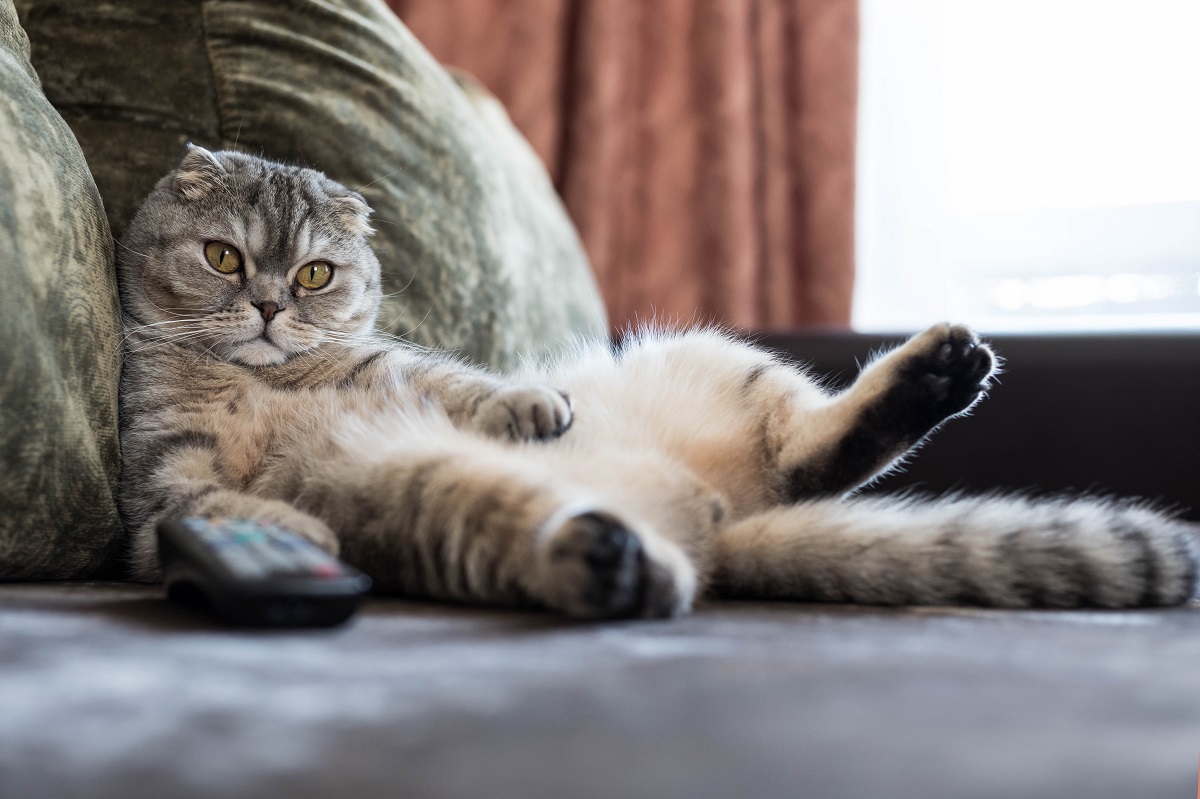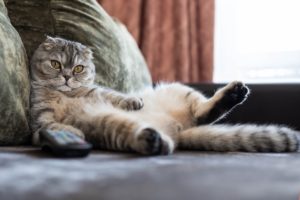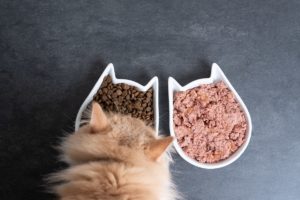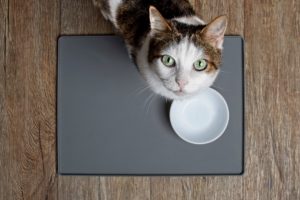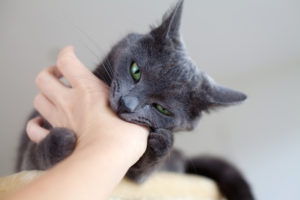Your favorite feline has a round silhouette and can be accurately described as “chonky.” So cute, right?! While your kitty may look totally adorable, and seem happy, an overweight cat is at higher risk for diabetes, arthritis, and other health problems. As veterinarians, we know how much you love your cat—after all, we do, too! If you’re not sure how to get a cat to lose weight, we can help you ensure that your favorite “chonk” lives a longer, happier life by putting them on a diet.
Guidance from Your Veterinarian
First, it’s important to discuss your cat’s ideal body weight with your family veterinarian before deciding how to put a cat on a diet. They can help devise a personalized weight loss plan for your cat—which may include an over-the-counter or prescription calorie-restricted cat food, daily calorie goals, and realistic weight loss goals. Your veterinarian can also screen your kitty for medical problems that may make it difficult to lose weight by performing blood and urine tests. If your kitty is experiencing any arthritis pain or mobility issues that may impact their ability to burn calories through exercise, your veterinarian can help with that, too! Most importantly, your vet can develop a nutrition plan that pinpoints exactly how many calories per day your cat’s diet should contain to achieve weight loss.
Expectations Around the Household
After you’ve received the “all clear” from your veterinarian to implement a weight loss program for your obese or overweight cat, it’s important for everyone in the household to be on board with kitty’s goals. On average, a ten-pound neutered or spayed cat only needs to eat about 200 calories per day—so that extra piece of pizza crust or small slice of cheese can have a BIG effect on your cat’s weight!
Remember to feed your cat for their goal weight, and not for their current weight. Make sure the humans in the household are aware of your kitty’s daily calorie goals, and if they must give cat treats, they are in pre-measured amounts of a suitable type. Some of our favorites are the high-protein dehydrated chicken or salmon treats, or dental treats.
Daily Food and Treat Rationing
Now that you have instructions from your veterinarian about how many calories per day should be included in your cat’s diet, check out the packaging on your cat’s food—prescribed or otherwise—to determine what volume of cat food they need per day to meet their goal. Then, divide this amount into several smaller meals.
Try to create a goal of your kitty doing something active prior to receiving each portion of food throughout the day. This helps them burn more calories through exercise AND it satisfies their natural instincts of chasing/hunting activity prior to receiving a meal. It’s a win/win for their physical and mental health!
Daily Physical Activity and Exercise
For physical activity, you can choose to have a play session prior to feeding or utilize one of the many feline foraging/food puzzle toys on the market today. If you are incorporating a play session, keep in mind that your overweight cat probably has to build up some stamina—and they may only be able to play for five minutes or so before needing a break. As they lose weight and build muscle, though, you should be able to increase the length of their playtime by about five minutes every week or so.
Make sure to choose toys that your cat is the most interested in playing with––for some cats, this could be a feather-on-a-stick toy, while for others, it might be a ball rolling around inside a toy. If you are using a laser pointer-type toy, make sure to let the cat “catch” the laser when you’re done with the play session—don’t leave them hanging!—before you feed them.
Regular Weigh-Ins
Finally, the most important part: how do you know when you are succeeding at helping your cat lose weight? The same way humans know if we’ve lost weight! At the beginning of your cat’s weight loss journey, weigh them on your bathroom scale to get a starting point— your cat’s weight on your scale at home may be slightly different than at the vet’s office, and that’s okay! (Hint: Sometimes it’s easier to weigh yourself holding your kitty, then weigh yourself to subtract and obtain kitty’s true weight.)
Weighing your cat at home allows you to compare your cat’s weight on the same scale over time without having to take them into the veterinary office. Keep your cat’s weight diary on your refrigerator, or in the “Notes” section of your phone, so that you have a record of their progress. Re-weigh your cat every one to two weeks to ensure you are making progress—and remember, even a quarter of a pound (0.25lb) is significant weight loss for your favorite feline! Make sure to ask your veterinarian when they would like to recheck kitty in the clinic to evaluate their weight-loss goals, too.
Tips & Tricks for Successful Weight Loss
If your cat appears hungry all the time because they are eating fewer calories, make sure to distract them with plenty of love, toys, and cat furniture to make the rest of their kitty life as happy as possible. You can also add water to their canned or dry cat food to make them feel more full and satisfied at each meal. This tactic also reduces stress and improves the health of their kidneys and bladder, decreasing the likelihood of kidney disease. If you feel like your cat’s quality of life on the diet is still suffering, see your veterinarian about changing foods to one that may be higher in fiber and more satiating to your kitty.
Maintaining an ideal body weight for your cat keeps them active and healthy for many years to come. By controlling your kitty’s calories, you are truly helping them live their best life!
Our AskVet Veterinarians are available to discuss all of your pet’s special needs 24 hours a day, 7 days a week. Whether it’s learning how often should you feed a cat, the various toxic foods for cats, or understanding the difference between wet vs. dry cat food, just sign into your account, and one of our friendly and knowledgeable veterinary experts will attend to your needs, no appointment required!
Written by:
Allison Ward, DVM
Dr. Allison Ward grew up in the suburbs of Washington, D.C. and started working in veterinary hospitals when she was 14 years old. After graduating from veterinary school in 2011, she completed a small animal rotating internship in New Jersey, followed by a neurology/neurosurgery internship in Miami. After completing this advanced training, Dr. Ward then moved on to general small animal practice. Dr. Ward’s professional interests include feline medicine, neurology, and pain management. Her passion for educating pet owners carries over into her work with AskVet, and she loves being able to help pets and their parents at all times of the day (and night!). She currently resides in sunny south Florida with her two cats, Larry and George.

